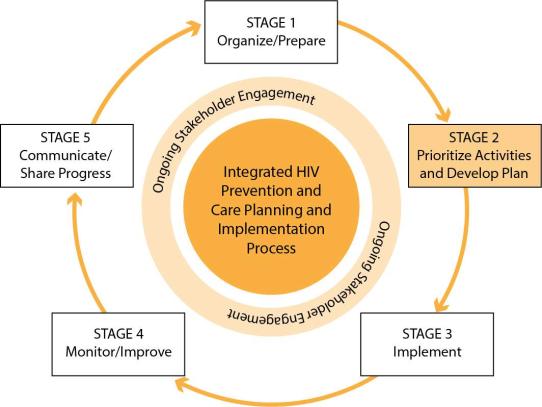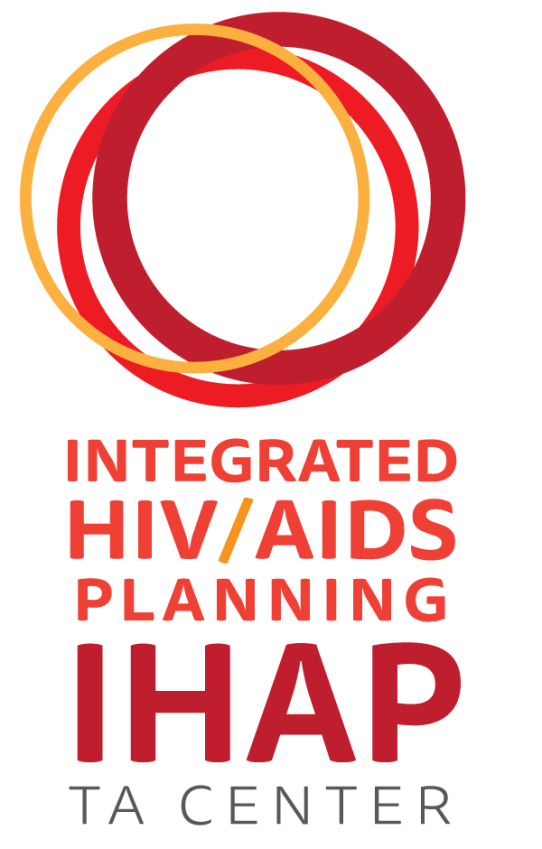
In Stage 2, jurisdictions develop, refine, finalize, and disseminate the Integrated Plan. Following data analysis, the recipient(s) (RWHAP Part A, RWHAP Part B, and/or CDC-funded prevention recipient) - with their planning bodies - follows established timelines and protocols to outline priorities and develop the Integrated HIV Prevention and Care Plan. Jurisdictions should build on prior planning experiences by applying lessons learned and best practices established during previous plan development processes (e.g., previous Integrated HIV Prevention and Care Plan, Getting to Zero, Ending the Epidemic Plans).
Promising Practices and Tips
- If previous and adequate plans exist, align integrated planning as a way to ensure consistency across goals, strategies, and performance measures. Aligning activities will also help facilitate collaboration between public health departments, community members, and stakeholders.
- Use local data and stakeholder input to develop goals and objectives that align with national priorities and the HIV care continuum.
- Develop timelines that account for draft development plus multiple rounds of review and revisions as appropriate.
- Reference the federal guidance to ensure you have all the necessary information to draft the required sections.
- Ensure there are sufficient resources and dedicated leadership for plan development.
- If using an external consultant to help develop the plan, ensure that planning body/planning council members are engaged in the process, understand the requirements and terminology, and have opportunities to provide feedback and input throughout development.
- During the plan development process, concurrently develop a monitoring plan to ensure effective and responsive tracking of progress and successes.
- Ensure an inclusive planning process by incorporating ongoing planning body and key stakeholder feedback.
Tools and Resources
- Crosswalk of the Integrated HIV Prevention and Care Plan Guidance (CY 2016-2021 and CY 2022-2026) and the Ending the HIV Epidemic in the U.S. Program Guidance (January 2022). This resource crosswalks the required components of the 2022-2026 Integrated HIV Prevention and Care Plan with the components of the 2016-2021 Integrated HIV Prevention and Care Plans and the EHE Planning Program Guidance.
- Fillable Checklist: CY 2022 – 2026 CDC DHP and HRSA HAB Integrated Prevention and Care Plan Guidance Checklist (January 2022). The checklist is a new feature required in the submission of the Integrated Plans for 2022-2026. Use this fillable checklist to outline which elements required new content and which elements were developed as part of another jurisdictional plan.
- Making the Case with Data: Epidemiologic Snapshots, Resource Inventories and Needs Assessments (February 2022). During this webinar, the IHAP TAC team reviewed the relationship between Section III of the Guidance and CDC and HRSA requirements for conducting an HIV needs assessment as well as demonstrated use of the HIV Resources Inventory Compiler, a new IHAP TAC tool that will be available soon!
- Integrated Guidance for Developing Epidemiologic Profiles: HIV Prevention and Ryan White HIV/AIDS Program Planning (March 2022). CDC and HRSA have updated the epidemiologic profile guidance to reflect new data sources and new core questions that align with the National HIV/AIDS Strategy (2022–2025) (NHAS) and the Ending the HIV Epidemic in the U.S. (EHE) initiative. The document provides one set of guidance to help profile writers produce integrated epidemiologic profiles and advise them on how to interpret epidemiologic data in ways that are consistent and useful in meeting the planning and evaluation needs of both HIV prevention and care programs.
- Situational Analysis: Pulling it All Together (March 2022). In this webinar, presenters from NASTAD reviewed the Situational Analysis requirements and shared lessons learned from jurisdictions that developed a Situational Analysis for their EHE Plans.
- Exemplary Integrated HIV Prevention and Care Plan Sections. This resource highlights exemplary sections from the 2016-2021 Integrated Plans.
- HIV Prevention, Care and Treatment Resource Inventory Compiler (February 2022). This resource supports the collection and analysis of information about HIV funding in the jurisdiction. The Excel tool generates a formatted table for inclusion in the Integrated Plan submission and a dashboard for data analysis.
Main contents page for curriculum
